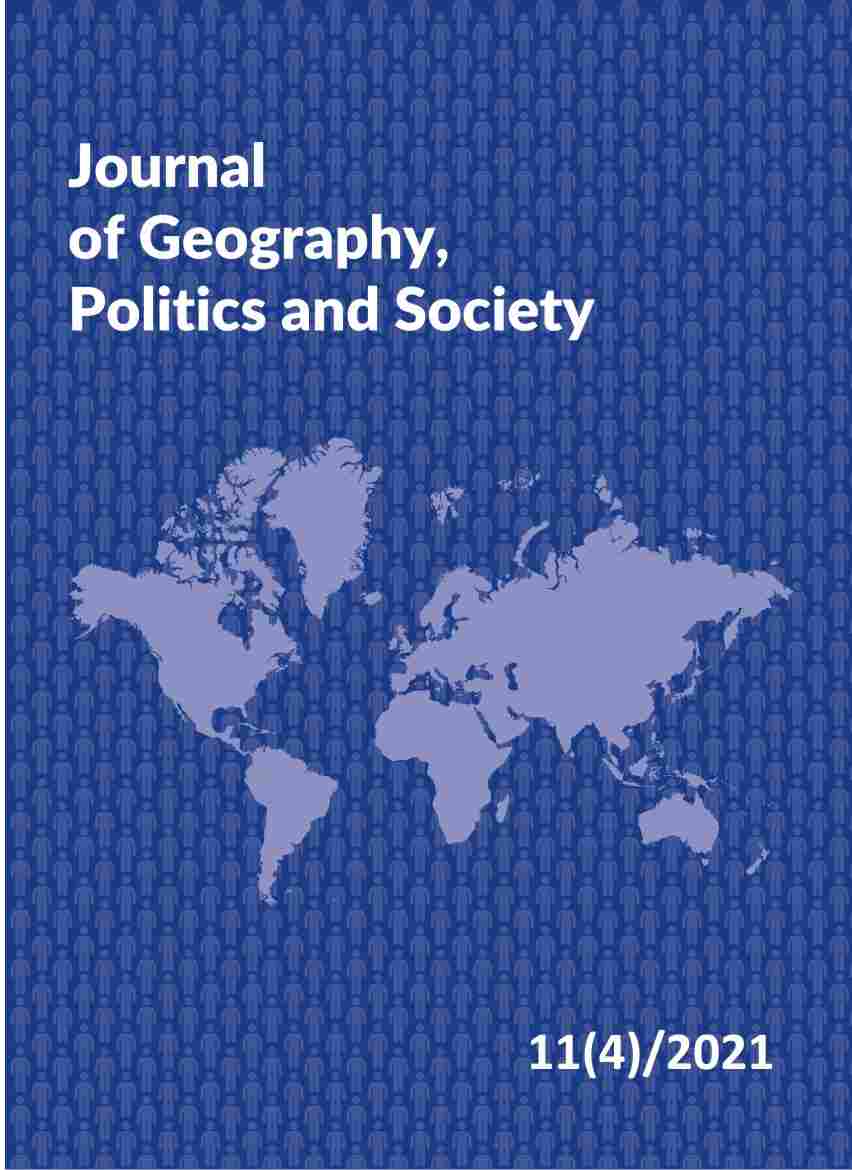Compliance-Gaining Theory as a Method to Analyze U.S. Support of the Free Syrian Army (FSA)
DOI:
https://doi.org/10.26881/jpgs.2021.4.03Keywords:
civil war, collaboration, compliance-gaining theory, Free Syrian Army, global policy, persuasion, Syria, United StatesAbstract
This paper examines U.S. support of the Free Syrian Army (FSA) through compliance-gaining theory. By and large, the theory describes how one party is able to get another party to comply with specific demands. The particular compliance-gaining tactics explored in this analysis are ingratiation, debt, guilt, and compromise. Thanks to these tactics, we can better understand how a rebel group like the FSA has managed to convince a superpower like the U.S. to support it, in spite of the historical implications of supporting rebel groups in the past. To make its compliance-gaining stronger, the FSA has played up ideas or concepts like oil, trust, blame, obligation, and past U.S. military interventions to collaborate with the U.S. so as to bring down the Syrian government and, by the same token, resist Russian influence in Syria.
Downloads
References
Alami M., 2016, Can FSA get back on its feet after Russian intervention?, Al-Monitor, 1 January 2016, A1.
Arango T., Barnard A., Saad H., 2012, Syrian rebels tied to Al Qaeda play key role in war, The New York Times, 8 December 2012, A1.
Barnard A., Shoumali K., 2015, U.S. weaponry is turning Syria into proxy war with Russia, The New York Times, 12 October 2015, A1.
Black I., 2015, US axes $500m scheme to train Syrian rebels. The Guardian, 9 October 2015, A1.
Blanchard C.M., Humud, C.E., Nikitin M.B.D., 2014, Armed conflict in Syria: overview and US response, Library of Congress Congressional Research Service, Washington.
Blaney J.R., Benoit W.L., Brazeal L.M., 2002, Blowout! Firestone’s image restoration campaign, Public Relations Review, 28(4), 379–392. doi: 10.1016/S0363-8111(02)00163-7.
Brinson S.L., Benoit W.L., 1999, The tarnished star: Restoring Texaco’s damaged public image, Management Communication Quarterly, 12(4), 483–510. doi: 10.1177/0893318999124001.
Buchanan P.J., 2015, The U.S. and Russia in Syria: War party targets Putin and Assad, The Washington Report on Middle East Affairs, 34(8), 24–26.
Burgoon J.K., Pfaud M., Parrott R., Birk T., Coker R., Burgoon M., 1987, Relational communication, satisfaction, compliance-gaining strategies, and compliance in communication between physicians and patients, Communication Monographs, 54(3), 307–324. doi: 10.1080/03637758709390235.
Carpenter T.G., 2013, Tangled web: The Syrian civil war and its implications, Mediterranean Quarterly, 24(1), 1–11. doi: 10.1215/10474552-2018988.
Coll S., 1992, Anatomy of a victory: CIA’s covert afghan war, The Washington Post, 19 July 1992, A1.
Cragin R.K., 2015, Semi-proxy wars and U.S. counterterrorism strategy, Studies in Conflict & Terrorism, 38(5), 311–327. doi: 10.1080/1057610X.2015.1018024.
DeYoung K., 2013, U.S. vows to double nonlethal aid to Syrian rebels as opposition backers reach accord, The Washington Post, 20 April 2013, A1.
Entous A., 2014, Syrian rebels seek U.S. antiaircraft missiles, The Wall Street Journal, 11 May 2014, A1.
Gass R.H., Seiter J.S., 1990, Persuasion, social influence, and compliance gaining, Allyn & Bacon, Boston. Gordon R.A., 1996, Impact of ingratiation on judgments and evaluations: A meta-analytic investigation, Journal of Personality and Social Psychology, 71(1), 54–70. doi: 10.1037/0022-3514.71.1.54.
Hehir A., Pattison J., 2015, Introduction: The responsibility to protect after the Arab Spring, Cooperation and Conflict, 50(4), 10–21. doi: 10.1177/0010836715612853.
Karam Z., Surk B., 2014, Syrian rebels name new military commander, The Washington Times, 17 February 2014, A1.
Katz M.N., 2006, Putin’s foreign policy toward Syria, Mason Archival Repository Service, Fairfax.
Le Billon P., El Khatib F., 2004, From free oil to “freedom oil:” Terrorism, war and US geopolitics in the Persian Gulf, Geopolitics, 9(1), 109–137. doi: 10.1080/1465004041233130785.2
Leenders R., 2013, How the Syrian regime outsmarted its enemies, Current History, 112(758), 331–337. doi: 10.1525/ curh.2013.112.758.331.
Littell J., 2015, Syrian notebooks: Inside the Homs uprising, Verso, London.
Margalit A., 2009, On compromises and rotten compromises, Princeton University Press, Princeton.
Marwell G., Schmidt D.R., 1967, Dimensions of compliancegaining behavior: An empirical analysis, Sociometry, 30(4), 350–364.
Miller G., DeYoung K., 2015, Secret CIA effort in Syria faces large funding cut, The Washington Post, 12 June 2015, A1.
Newman A., 2013, What is the Obama-backed Free Syrian Army?, The New American, 17 September 2013, A1.
O’Bagy E., 2013, The free Syrian army, Institute for the Study of War, Washington.
Onyekwere E.C., 1991, Situational influence in persuasive communication, Africa Media Review, 5(1), 75–86.
Ralston D.A., 1985, Employee ingratiation: The role of management, Academy of Management Review, 10(3), 477– 487. doi: 10.5465/amr.1985.4278963.
Schenck-Hamlin W.J., Wiseman R.L., Georgacarakos G.N., 1982, A model of properties of compliance gaining strategies, Communication Quarterly, 30(2), 92–100. doi: 10.1080/01463378209369434.
Schmitt E., 2012, C.I.A. said to aid in steering arms to Syrian opposition, The New York Times, 21 June 2012, A1.
Skålén P., Abdul Aal K., Edvardsson B., 2015, Cocreating the Arab Spring: Understanding transformation of service systems in contention, Journal of Service Research, 16(4), 10–21. doi: 10.1177/1094670514559700.
Sly L., 2012, Syrian rebels feel abandoned, betrayed by U.S., The Washington Post, 7 August 2012, A1.
Solomon J., Malas N., 2012, U.S. bolsters ties to fighters in Syria, The Wall Street Journal, 13 July 2012, A1.
Spencer R., 2015, Christian militia takes the war to Islamic State in Syria, The Telegraph, 23 February 2015, A1.
Thompson L., Hastie R., 1990, Social perception in negotiation, Organizational Behavior and Human Decision Processes, 47(1), 98–123. doi: 10.1016/0749-5978(90)90048-E.
Wilson S.R., Aleman C.G., Leatham G.B., 1998, Identity implications of influence goals: A revised analysis of face-threatening acts and application to seeking compliance with same-sex friends, Human Communication Research, 25(1), 64–96. doi: 10.1111/j.1468-2958.1998.tb00437.x.
Wittebols J.H., 1991, The politics and coverage of terrorism: From media images to public consciousness, Communication Theory, 1(3), 253–266. doi: 10.1111/j.1468-2885.1991. tb00018.x.
Zuhur S., 2015, The Syrian Opposition: Salafi and nationalist jihadism and populist idealism, Contemporary Review of the Middle East, 2(1), 143–163. doi: 10.1177/0169796X15584034.

 Academic Scientific Journals
Academic Scientific Journals




